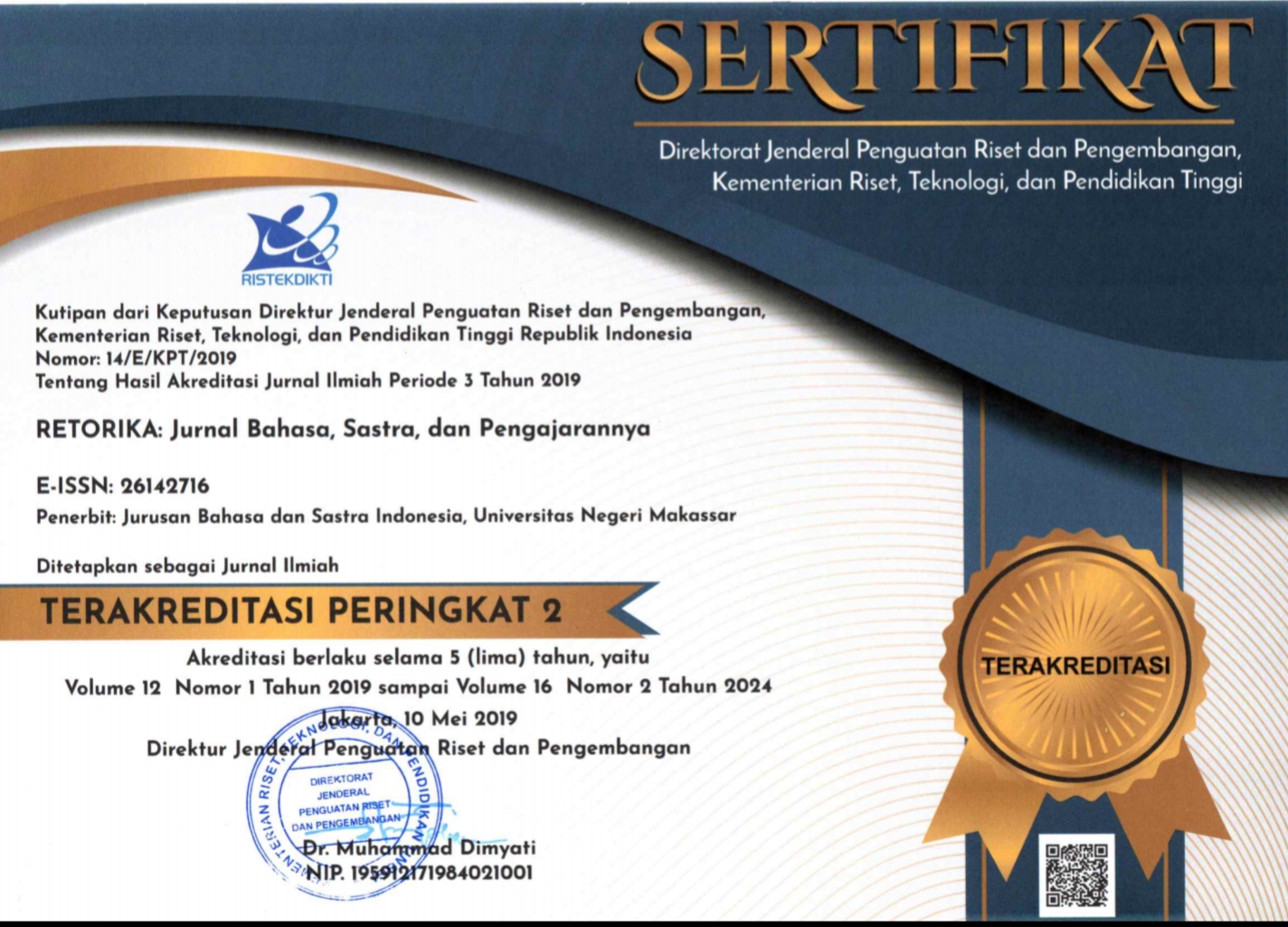WOMEN BODY AND ITS FUNCTIONS IN DYSTOPIAN LITERATURE: SEXUAL COMMODITY, SEXUAL PLEASURE, AND REPRODUCTIVE NATURE
(1) UIN Syarif Hidayatullah Jakarta
(2) UIN Syarif Hidayatullah Jakarta
(*) Corresponding Author
DOI: https://doi.org/10.26858/retorika.v15i2.17913
Abstract
Keywords
Full Text:
PDFReferences
Abdelbaky, A. (2016). A Perfect World or an Oppressive World: A Critical Study of Utopia and Dystopia as Subgenres of Science Fiction. Smart Moves Journal IJELLH, 4(3), 17. https://doi.org/10.24113/ijellh.v4i3.1201
Basu, A. (2005). Realm of Possibilities: The Portrayal of Women in Futuristic Science Fiction Movies Science Fiction Movies. Rochester Institute of Technology.
Beauvoir, S. de, Borde, C., Malovany-Chevallier, S., & Thurman, J. (2011). The second sex. Vintage.
Bruce, I. (2019). Android Women and the Body Electric: Sex and Gender in the Post-Human Worlds of Film. 63.
Domingo, R. (2017). Feminist Critique of Posthuman Embodiment in Mamoru Oshii’s Film Ghost In The Shell [Department of Gender Studies]. Central European University.
Dvorsky, G., & Hughes, J. (2008). Postgenderism: Beyond the Gender Binary. 18.
Fajarwati, A., Mei, E. T. W., Hasanati, S., & Sari, I. M. (2016). The Productive and Reproductive Activities of Women as Form of Adaptation and Post-disaster Livelihood Strategies in Huntap Kuwang and Huntap Plosokerep. Procedia - Social and Behavioral Sciences, 227, 370–377. https://doi.org/10.1016/j.sbspro.2016.06.084
Finnsson, G. (2016). The Unexpected Popularity of Dystopian Literature: From Orwell’s Nineteen Eighty-Four and Atwood’s The Handmaid’s Tale to Suzanne Collins’ The Hunger Games Trilogy. University of Iceland.
Haraway, D. (1991). A Cyborg Manifesto: Science, Technology, and Socialist-Feminism in the Late Twentieth Century. Routledge.
Hogsette, David. S. (2019). The Tyranny of Masculine Creation and the Potency of a Replicant Adam and Eve Mythology: Postsecular Critique of Materialism in the Blade Runner Films. 11. https://www.davidhogsette.com/postsecularism-in-the-blade-runner-films/
Martinez, V. A. (2019). The Female Nature: Representations Of Motherhood And Nature In Dystopian Films [University of Texas at El Paso]. https://scholarworks.utep.edu/cgi/viewcontent.cgi?article=3873&context=open_etd
Moleong, L. J. (1990). Metodologi Penelitian Kualitatif. PT. Remaja Rosdakarya.
Morling, A. (2018). ‘We make angels’: Rediscovering the Victorian ‘Angel in the House’ in Spike Jonze’s Her (2013) and Denis Villeneuve’s Blade Runner 2049 (2017). 13.
Mulvey, L. (1975). Visual Pleasure and Narrative Cinema. Screen, 16(3), 6–18. https://doi.org/10.1093/screen/16.3.6
Murphy, C. F. (1995). Beyond feminism: Toward a dialogue on difference. Catholic University of America Press.
Ponterotto, D. (2016). Resisting the Male Gaze: Feminist Responses to the “Normatization” of the Female Body in Western Culture. 17(1), 20.
Rosen, C. (2003). Why Not Artificial Wombs? The New Atlantis, 3, 67–76.
Rosida, I. (2018). Tubuh Perempuan Dalam Budaya Konsumen: Antara Kesenangan Diri, Status Sosial, dan Nilai Patriarki. Jurnal Antropologi: Isu-Isu Sosial Budaya, 20(1), 85. https://doi.org/10.25077/jantro.v20.n1.p85-101.2018
Rosida, I., & Soraya, A. (2017). Gender Relation in Willow Trees Don’t Weep Novel (2014) by Fadia Faqir: A Feminist Literary Criticism. Journal of Islam and Humanities, 2(1), 13–28.
Shefer, T. (1990). Feminist Theories of the Role of the Body Within Women’s Oppression. Critical Arts, 5(2), 37–54. https://doi.org/10.1080/02560049008537635
Sinai, D. R. (2019). Moving Towards Agency: How Technology of the Self can Liberate Humans from the Social Constraints of Biological Sex. OCAD University.
Villeneuve, D. (2017, October 3). Blade Runner 2049 [Science Fiction; 720P]. Warner Bros Pictures.
Article Metrics
Abstract view : 432 times | PDF view : 259 timesRefbacks
- There are currently no refbacks.
Copyright (c) 2023 Avi Ainul Fikri, Ida Rosida

This work is licensed under a Creative Commons Attribution-NonCommercial 4.0 International License.
Published by:
Department of Indonesian Language, Faculty of Languages and Literature, Universitas Negeri Makassar in cooperate with Asosiasi Dosen Bahasa dan Sastra Indonesia (ADOBSI) and Ikatan Program Studi Pendidikan Bahasa dan Sastra Indonesia (IKAPROBSI).
Address: Department of Indonesian Language Office, DG Building Second Floor, UNM Parangtambung, Daeng Tata Raya Street, Makassar, South Sulawesi, Indonesia
 Email: retorika@unm.ac.id
Email: retorika@unm.ac.id

RETORIKA: Jurnal Bahasa, Sastra,dan Pengajarannya is licensed under a Creative Commons Attribution-NonCommercial 4.0 International License.
















